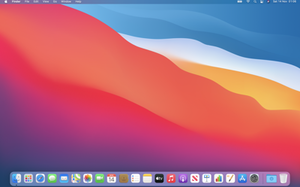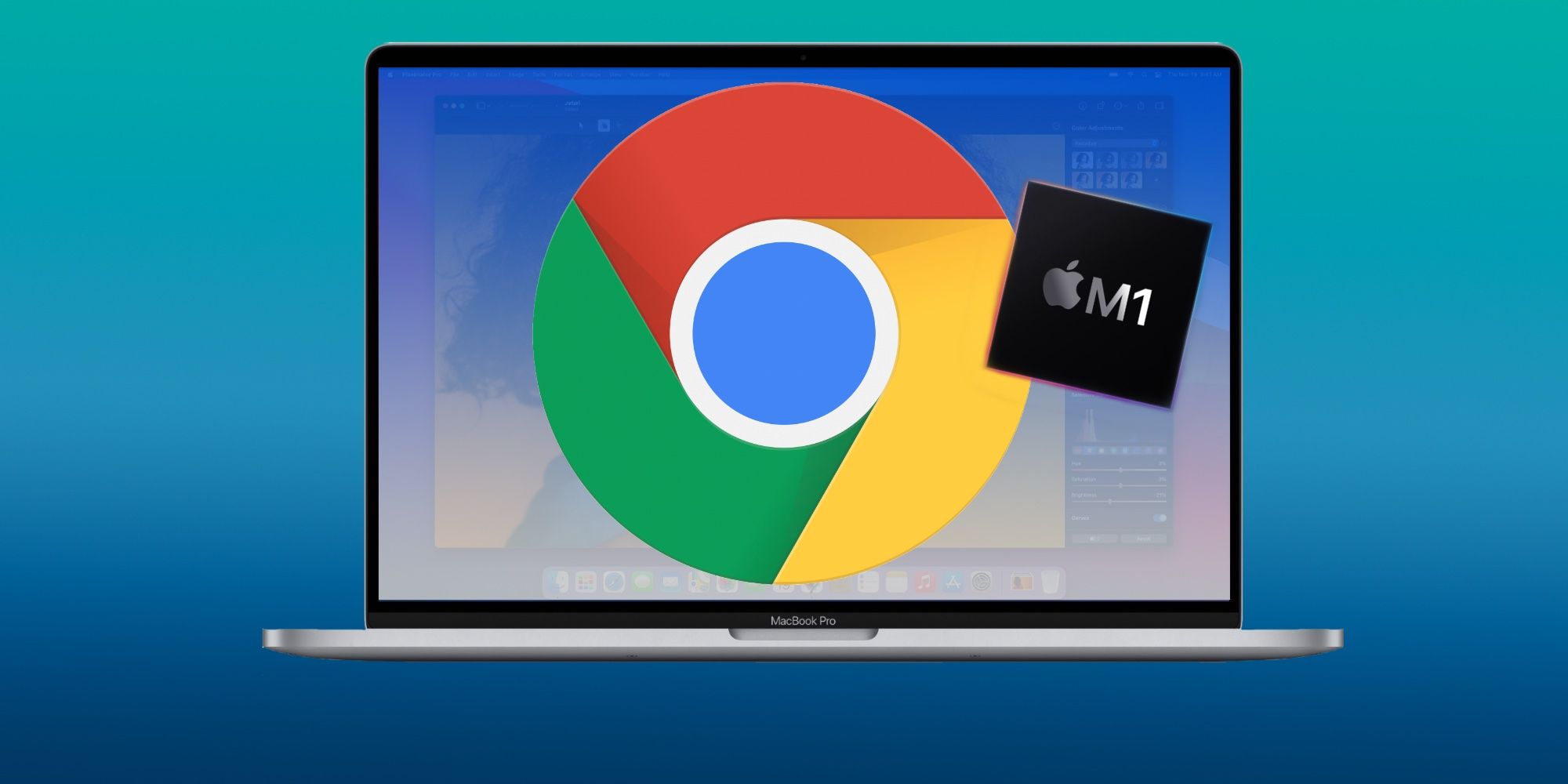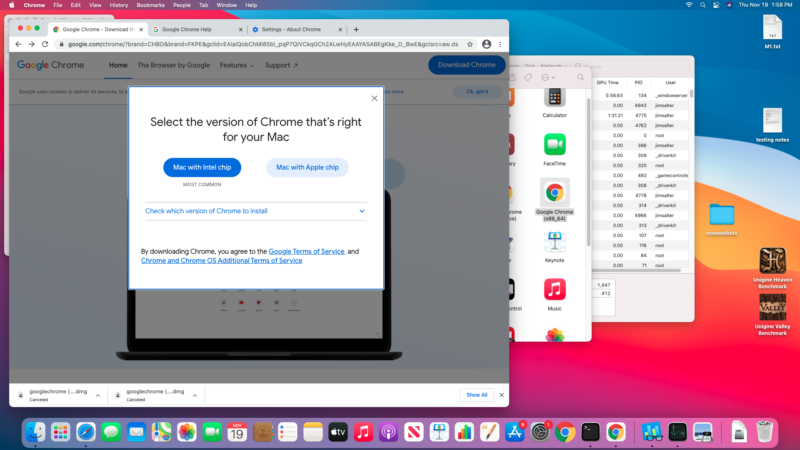Pros
Jaw-dropping battery life
Incredible performance
Iconic build quality
Select Google Chrome. Today's best Apple Macbook Air (M1 2020) deals. 2020 Apple MacBook Air with. 2020 MacBook Air 13. Google Chrome is finally available for Apple’s new Macs with its M1 chip after a few roadblocks. The company had to pause the rollout yesterday after many users complained about app crashes. . SEARCH WITH GOOGLE - Chrome is the browser with Google built-in. Search and get answers on Google quickly. BROWSE FAST - Choose from personalized search results that instantly appear as you type and quickly browser previously-visited websites. SYNC YOUR CHROME - When you sign into Chrome, your bookmarks, saved passwords,. Google today updated its Chrome browser for macOS to version 87.0.4280.66. MacBook Air; MacBook Pro 13' MacBook Pro 16'. 2020 10:02 am PST by Juli Clover.
Early 2020 Macbook Air
Apple is killing it with the new M1 Mac lineup. For the same price (or less!) as its previous Intel-based Macs, you’re getting a laptop that is more powerful, way more power efficient, and way quieter. The difference is particularly pronounced on the MacBook Air, which screams at its $1,000 base price.
Google Chrome Macbook Air 2020 A2179
While the new MacBook Air comes with jaw-dropping battery life and a blazing-fast processor, it’s not the perfect laptop for everyone—its integrated graphics don’t hold a flame to gaming laptops. However, its processor performance more than makes up for its graphics performance. Video editing and multitasking are a breeze on the Air.
When the new M1 Macs came out in November, we were impressed with their performance but also worried that the new ARM-based processors would have compatibility issues with apps made for the older Intel-based Macs. Thankfully, the M1 MacBook Air put those concerns to rest, with many older apps running almost as well as native apps.
About the Late 2020 M1 MacBook Air
While the MacBook Air has traditionally been aimed at casual everyday users, the M1 processor is the same that powers the new MacBook Pro, bringing the Air’s capabilities up to par for all but the most demanding tasks. If you plan on doing some casual gaming or video editing, we recommend splurging on the pricier MacBook Pro with an 8-core integrated GPU, which should give you a slight bump in graphics performance over the base model.
Here are the specs on the base model M1 Macbook Air:
- Processor: Apple M1 8-Core Processor, with 7-core integrated GPU (8-core GPU also available)
- Memory: 8 GB RAM (16 GB RAM upgrade also available)
- Storage: 256 GB RAM (512 GB, 1 TB, 2 TB also available)
- Display: 13.3” LED-backlit IPS display at 2560p x 1600p resolution
- Ports: 2 x Thunderbolt 3; 3.5mm headphone jack
- Keyboard and Trackpad: Magic Keyboard with backlighting; Force Touch trackpad; Touch ID sensor
- Camera: 720p webcam
- Graphics: 8-Core Integrated GPU
- Connectivity: Wi-Fi 6; Bluetooth 5.0
- Battery: 49.9 Watt-hour battery
- Weight: 2.8 lbs
- Dimensions: 0.63” x 11.97” x 8.36”
- Warranty: 90 days complimentary technical support and a one year warranty
What We Like
Its battery life is long enough to marathon the Lord of the Rings movies
If you watch all three extended edition movies for the Lord of the Rings trilogy, you will spend 11 and a half hours immersed in Middle Earth. If you watch them all on a fully charged M1 MacBook Air, you will have a little over an hour to spare to tweet about your marathon—just enough time to go back and save the Shire. That’s right, the MacBook Air lasted 12 hours and 49 minutes on our Google Chrome-based battery test. That’s almost 4 hours longer than the HP Spectre x360 14, the longest-lasting Windows machine we’ve tested until now.
Related content
review
Lenovo ThinkPad X1 Nano Laptop Review
The only thing preventing the Air from claiming the battery life crown is the other M1 MacBook, the MacBook Pro 13, which offers almost 14 hours per charge. This discrepancy is due to the MacBook Pro’s slightly bigger battery, since they both draw similar amounts of power. Regardless, both the M1 Air and the M1 Pro last much longer than the mid-2020 Intel MacBook Pro 13, which puttered out after 7 hours.
The M1 Silicon processor is leagues ahead of Intel and AMD
When you lift the lid, the MacBook Air wakes instantly, regardless of how many programs and tabs you may have open (trust me, I usually have 100+ Chrome tabs and five programs open at any given time). During benchmarks, Apple’s new M1 chip often starts up 10%, 20%, even 30% or more ahead of the competition. When we tested the M1 MacBook Pro, we didn’t see any discernible performance difference against the MacBook Air. However, the mid-2020 Intel MacBook Pro and Intel MacBook Air feel like two snails in the M1 MacBooks’ tracks.
The only laptop able to keep up with M1 Macs was the Asus ROG Zephyrus G14, which has an AMD Ryzen 9 processor (i.e. AMD’s flagship mobile processor). Compared to the Intel-based Dell XPS 13 9310, one of its closest competitors, the M1 MacBook Air is a whopping 42% faster in the multicore Geekbench 5 test. In Basemark, which tests web-based performance, the MacBook Air pulls ahead by a still-insane 22%.
The MacBook Air’s GPU performance was about on par with its Windows competition—which is impressive, given that it has no fan. If you do casual gaming, from the occasional round of Rocket League to some less-demanding AAA games, you’ll be pleasantly surprised by the new Air.
We pulled 23 frames per second on World of Warcraft's max settings, which is lower than the 33 fps the new MacBook Pro achieved. The two laptops have the same GPU, but on the Air you only get 7 working cores instead of 8 (this is a common tactic to keep costs down and avoid throwing away the part if one core comes out busted). If you want a full 8-core GPU you can get it on the Air, but you have to step up to the $1,249 model. Both of the M1 MacBooks cream the Intel 13-inch MacBook Pro, which struggled to run 25 frames per second at medium settings (setting 5 of 10)—the M1 MacBook Air runs at nearly 60 frames per second on those same graphics settings.
Where the MacBook Air really shines is in web performance and code writing. The processor feels ridiculously snappy, with windows loading instantly and scripts running smoothly. Unless you need a graphics powerhouse, it’s hard to imagine anyone being dissatisfied with the MacBook Air’s performance.
Rosetta’s Rollout has been extremely smooth so far
While the M1 processor runs beautifully when used for native ARM apps (such as those written for the new M1 Macs specifically, or iPhone and iPad apps), there are still many apps that must run through Rosetta, Apple’s x86 architecture emulation program. Basically, most PCs run on “x86” architecture, including all the recent Macs and almost every Windows laptop and Chromebook. These new MacBooks use Apple’s new M1 processor, which runs on an “ARM' architecture, just like iPads and iPhones.
The problem? Apps have to be written for one or the other, so existing x86 apps need to be re-written to work on the new Macs.
Apple knew that this incompatibility could be a problem, so the M1 Macs ship with Rosetta, an emulator that can run apps that are designed for x86 machines. This doesn’t require any extra work on your part; the computer will ask you to automatically download Rosetta when you try to launch an x86 app for the first time, so your old apps should just work.
When we first started messing with the M1 Macs in November, the Mac Mini had trouble running Steam and some games meant to run on Mac. In January, Steam is running as smoothly on the MacBook Pro and Air as it does on the 2020 Intel MacBook Pro. Many major apps from companies like Google, Adobe, and Microsoft already have native M1 versions, as well.
The only apps we worry about running these days are video games and hardware drivers. We still have trouble launching some indie games like Among Us and Superliminal, although Mac-compatible AAA games have been fine. With hardware, I’ve had smooth sailing with my Bluetooth mice, USB-A audio interfaces, and USB-C keyboards, but there have been a few user complaints about the M1 MacBooks’ compatibility with Huion drawing tablets, for instance.
2020 Macbook Air
The new M1 processor can run iOS and iPadOS apps, too
For those of you who are glued to your iPhone or iPad because of its amazing app store, fret no more. You can now run these apps natively on the M1. For these new processors, Apple used the same architecture it has been using on its phone and tablet processors. The obvious problem is the Air does not have a touchscreen, so you will have to get used to using the touchpad. The result is that it’s most useful for apps that already planned for MacOS compatibility, but it would sure be great if Apple just put a touchscreen on its MacBooks (hint, hint).
The MacBook Air is silent and cool (literally)
Usually, a fanless laptop is not a snappy laptop, since it needs to be careful about overheating its processor. However, the M1 MacBook Air is a glorious exception to that rule, with some of the snappiest performance we’ve ever seen from a laptop, period.
Because it’s fanless, the MacBook Air runs silently regardless of how many tasks it’s juggling. More importantly, the Air still manages to stay significantly cooler than the Intel Macs, despite its lack of fan. It rarely feels warm at all.
It’s the same body as the Mid-2020 MacBook Air
When the last Air came out in the spring, we were delighted with the changes Apple brought: thin bezels, a beautiful Retina display, and most importantly, the Magic keyboard. The M1 Air is the same as the Intel Air in all but its processor. Otherwise, the M1 Air has the same screen, the same aluminum chassis, and the same glorious keyboard and touchpad.
What We Don’t Like


The port selection is awful
The M1 Air comes with two Thunderbolt 3 ports and a headphone jack. Woe be to those who need more than a charger. You will have two ports to plug in displays, add microphones, connect dongles, or access an internal drive, hopefully not all at the same time. Sticking to Bluetooth peripherals and cloud-based services is basically a must for M1 users, given the sparseness of the port situation.
Though some users have reported Bluetooth connectivity issues, we haven’t had any problems. It's possible that some aging hardware peripherals may struggle with driver compatibility on the new M1 Macs, but most should be compatible if they're using standard drivers.
You can’t upgrade your computer
Apple decided to solder the memory and storage directly onto the M1 in order to have a more direct connection between the modules and the CPU, which Apple claims is faster and better for battery life. However, this also means that you have to pay a huge markup to increase storage and you’re stuck with whatever you bought on day one. For many, this won’t be a problem, but we would advise getting the upgraded model with at least 512 GB of SSD space if you don’t want to feel too constricted within a year or two.
Macbook Air 2020 Case
This also means that those who were hoping for a Mac with 32GB of memory will have to wait to see what the iMac and the Mac Pro have to offer for their next cycles. Otherwise, you’ll have to stick with an older Mac or a Windows/Linux PC if you want to have more hardware upgradeability.
Should you buy it?
The M1 MacBook Air is the fastest sub-$1,000 laptop by far, and it has the premium build quality and user experience to back up its performance. It has a remarkable 13-hour battery life, it’s silent, it runs faster than any other laptop in its range, it has a gorgeous Retina display, and it has a solid trackpad and keyboard.
Its only faults are that it only has two Thunderbolt 3 ports and its storage and RAM can’t be upgraded later on, but these are problems that have plagued MacBooks for a while and aren’t likely to go away.
:max_bytes(150000):strip_icc()/002-uninstall-google-chrome-mac-4581498-9be7b32b3a1c4e1db1b76d79100eeb07.jpg)
The M1 MacBook rollout has gone incredibly smoothly, with Rosetta always stepping up to translate older apps into the new Apple Silicon infrastructure—after months of use, I’ve only run into two apps that won’t launch. Unless you need a Windows PC or you’re looking for a professional-grade Mac, you will absolutely love the Air as much as I do.
Meet the tester
Emily is a staff writer for Reviewed, mainly focused on reviewing laptops and other consumer tech. During her free time, she lives in Hyrule and draws about her adventures.
Checking our work.
We use standardized and scientific testing methods to scrutinize every product and provide you with objectively accurate results. If you’ve found different results in your own research, email us and we’ll compare notes. If it looks substantial, we’ll gladly re-test a product to try and reproduce these results. After all, peer reviews are a critical part of any scientific process.
Shoot us an emailThe Google Chrome browser is now available as an Apple M1 native application, for those of you lucky enough to have M1 Mac Mini, Macbook Air, or Macbook Pro systems. (If you've been living under a rock for the last few weeks, the M1 is Apple's newest in-house-designed ARM silicon, which the company began selling in traditional form-factor laptops and Mac Minis for the first time this week.)Google presents Chrome for download as either an x86_64 package or an M1 native option—which comes across as a little odd, since the M1 native version is actually a universal binary, which works on either M1 or traditional Intel Macs. Presumably, Google is pushing separate downloads due to the much smaller file size necessary for the x86_64-only package—the universal binary contains both x86_64 and ARM applications, and weighs in at 165MiB to the Intel-only package's 96MiB.
Performance
In our earlier testing, we declared that the previous version of Google Chrome—which was available only as an x86_64 binary and needed to be run using Rosetta 2—was perfectly fine. That was and still is a true statement; we find it difficult to believe anyone using the non-native binary for Chrome under an M1 machine would find it 'slow.' That said, Google's newer, ARM-native .dmg is available today, and—as expected—it's significantly faster if you're doing something complicated enough in your browser to notice.The first benchmark in our gallery above, Speedometer, is the most prosaic—the only thing it does is populate lists of menu items, over and over, using a different Web-application framework each time. This is probably the most relevant benchmark of the three for 'regular webpage,' if such a thing exists. Speedometer shows a massive advantage for M1 silicon running natively, whether Safari or Chrome; Chrome x86_64 run through Rosetta2 is inconsequentially slower than Chrome running on a brand-new HP EliteBook with Ryzen 7 Pro 4750U CPU.
 Advertisement
Advertisement Jetstream2 is the broadest of the three benchmarks and includes workloads for data sorting, regular expression parsing, graphic ray tracing, and more. This is the closest thing to a 'traditional' outside-the-browser benchmark and is the most relevant for general Web applications of all kinds—particularly heavy office applications such as spreadsheets with tons of columns, rows, and formulae but also graphic editors with local rather than cloud processing. Chrome x86_64 under Rosetta2 takes a significant back seat to everything else here—though we want to again stress that it does not feel at all slow and would perform quite well compared to nearly any other system.

Finally, MotionMark 1.1 measures complex graphic animation techniques in-browser and nothing else. Safari enjoys an absolutely crushing advantage on this test, more than doubling even M1-native Chrome's performance. The Apple M1's GPU prowess also has an inordinate impact on these test results, with Chrome both native and x86_64 translated on the M1 outrunning Chrome on the Ryzen 7 Pro 4750U powered HP EliteBook.
